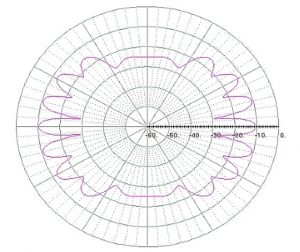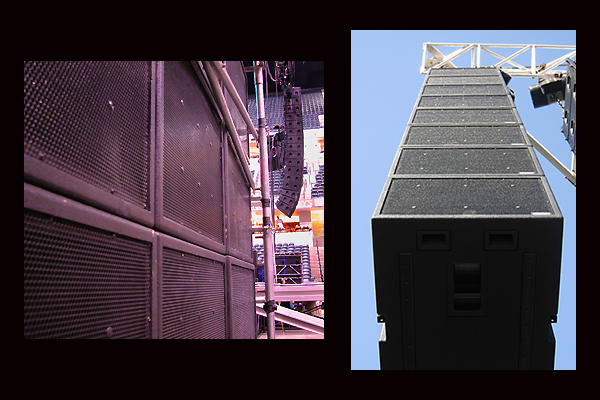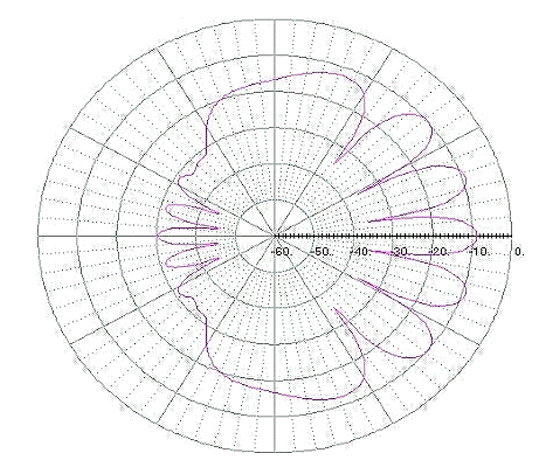We often describe bass as non-directional. This is because we’ve learned that loudspeakers much smaller than the wavelengths they’re radiating are normally non-directional, and we know that bass wavelengths are long – 20 feet at 55 Hz, for example.
In reality, bass is just low-frequency sound that obeys the same rules as sounds of other frequencies. In these rules, all dimensions are proportional to wavelength.
For bass, practical directivity issues arise because the wavelengths involved are so large. Some have a hard time actually believing that a big subwoofer box is actually non-directional in its operating range, but under “pure conditions,” it is.
By pure conditions, I mean: A) the box is by itself, not stacked or hung in an array of some kind; and B) the box is free enough from distortion that it isn’t putting out a directional beam of distortion harmonics that mask the real (non)directivity of the fundamental.
Directive distortion harmonics (point B above) are the usual reason for individual subwoofers seeming directional. Stand in front of a single box and you hear clear bass; stand off to the side and you hear muffled bass.
The conclusion is that the box is directional. The problem is that the only directional part is the part you don’t want: distortion.
When a bunch of subwoofers are stacked into a big array, the dimensions of the stack are large enough to create strong directional effects. Sometimes these effects help, sometimes they don’t. What happens depends upon the shape and size of the array, and on how the subwoofers are powered. Also, with multiple bass arrays (one array on each side of the stage, for instance), the interactions between/among them have powerful directional effects.
Let’s take a look at some of the more common types of subwoofer arrays and modeling graphs that show their horizontal directivities. The graphs shown with this article were generated by a simple bass array modeling program I wrote back in the 1980s. The program still works, which may not be too surprising since the laws of physics don’t change.
The graphs all assume a generic type of subwoofer box about 2 feet tall by 4 feet wide. Bass array directivity doesn’t depend much on individual box details. All curves are calculated for a listening distance of 150 feet on the floor. A 60-foot-wide stage is assumed.
1: Classic Left & Right Stacks
This is the configuration most often used, with the subwoofers in flat-front stacks at stage left and right. It’s popular for several reasons: easy setup, little interference with sightlines, and creation of a platform for stacking fill loudspeakers. It also adds a pair of little stage extensions for the star to leap onto in peak moments.
Figure 1 shows that the bass coverage from such arrays is kind of lumpy, and there’s quite a bit of sound coming off the back. In practice, the amount of sound coming off the back of the array isn’t as much as the modeling program shows.

However, the depiction of the lobing is accurate. Notice the lobe up the middle, surrounded by nulls. This is the classic “power alley” phenomenon observed by FOH mixers. The lobing problem is serious — the circles on the graphs are 10 dB apart, so there are big differences between the peaks and the valleys.
In reverberant venues, this problem is masked somewhat, because the valleys are filled in by the bass from the reverberant field of the room. In that case, the bass in a null area sounds unclear and somewhat weak, but not completely absent. Outdoors, though, when standing in a valley, the bass is just plain gone.
Another problem of this configuration is lack of coverage on the sides. In the vertical plane, there’s an additional droop, so for seats high and on the sides, there really isn’t much bass at all. That’s not acceptable for sold-out arena shows or for theatres with significant horseshoe shapes. The reverberant field helps some, but not enough.
2: Stair-Cased Left & Right Ground Stacks
This is the configuration I prefer to use for stacked subwoofers. The boxes are stacked conventionally, except that they’re stepped back, with each stack being about a foot upstage of the stack to its onstage side. The effect is the same as taking a flat-front stack and aiming it about 30 degrees offstage.
As we can see in Figure 2, the pattern is better behaved. Not perfect, but probably about as good as you can do in this configuration.
3: Flown Left & Right Stacks
This is the configuration most commonly used by for flying subwoofers for line arrays. The results of two stacks flown in vertical lines at front corners of a 60-foot stage are shown in Figure 3.
The best part of this configuration is that it puts out plenty of bass on the sides. The worst part is that the lobing (a.k.a., comb filtering) is severe.
The reason it’s so bad is that long, thin flown bass stacks are non-directional in the horizontal plane, which means that most of the people in the audience are hearing both the left and the right bass stacks at the same time. Only it’s not really at the same time, because the speakers are 60 feet apart.
So depending on where you’re sitting, there could be up to about 55 milliseconds of difference between the left and right sound waves. That’s a lot of time smear, and causes serious wave interference, which in turn generates considerable lobing and comb filtering.
If you get your hands on a bass rig like this, try an experiment: turn one side off. You might be surprised at how much better it sounds. Of course, you can’t use it that way, but it does demonstrate the problem.
One important benefit of flying the bass is not shown in our graphs: vertical coverage is much better. This is particularly important in arenas, where flying the subwoofers puts the upper, more distant audience sections in the middle of the array’s beam. The benefit is particularly noticeable at the sides of the stage.
4: Flown Left & Right Stacks Of Directional Subs
A few directional designs are now on the market, with these boxes using phase cancellation to produce microphone-like directional patterns — cardioid and hypercardioid, mainly.
Using directional subwoofers can help reduce the wave interference problems of the flown left-right array described just above. If the woofers are directional and if they’re aimed correctly, then there won’t be as many places in the audience that can hear both stacks at the same time, and interference will be less.
To get the desired effect, however, they must be pointed significantly off stage. If not, both sides will still be almost equally loud everywhere, and there will still be just as much interference as with conventional subwoofers.
Figure 4 shows what happens with two flown stacks of cardioid woofers pointing straight ahead. There’s less coming off the back, but lobing is bad.
In contrast, Figure 5 demonstrates the outcome of flying those same cardioid subwoofers, with each stack pointed 30 degrees offstage.
Lobing is reduced, although still significant. Unfortunately, front-to-back rejection is almost non-existent. Still, it’s a lot better than conventional subwoofers flown left-right.
I haven’t explored many different aiming scenarios for rigs like this, but I’m fairly certain there’s room for improvement. For example, hypercardioid subwoofers would probably work better than the cardioid ones modeled here.
5: Flown Single Stack
This configuration positions a single stack of subwoofers somewhere above center stage, usually near the downstage edge. It’s my favorite bass configuration.
Figure 6 tells a lot of the story. Coverage is very uniform and there’s no lobing at all.
A great feature of this approach is that for typical array sizes (12 feet to 16 feet high), there is a null 90 degrees off axis at about 55 Hz. This means that the stage doesn’t get blasted with sub-bass energy. Artists usually like this, and television producers love it.
Unfortunately, many productions can’t accommodate a line of subwoofers hanging in the middle, which is space often reserved for lighting or video. Sometimes it’s possible to hang the subwoofers higher up, above the other stuff. If the stack is wide (two subwoofers wide instead of one), the pattern will narrow, especially at the upper end of the sub-bass range.
To fly or to stack? Yes, that is the question! Often it depends on the act, your taste, the production budget and other factors.
Sonically, stacked bass has a solid, heavy quality with lots of punch, especially at the house mixing position. Flown bass has an airier, more melodic quality.
One potential issue with flown bass is floor bounce. This is a problem that mainly occurs in arenas. When bass bounces off a floor, reflections arrive at the seats (especially the upper seats) much later than the direct waves from the subwoofers, which causes time smear. The effect is quite noticeable in empty rooms, less apparent when the floor is covered with people.
With bass flown in two stacks, time smear between stacks is a constant problem, unless directional subwoofers are used properly, as I’ve illustrated here. Vertical coverage, especially at the sides of the stage, is definitely less of a problem with flown bass.




















